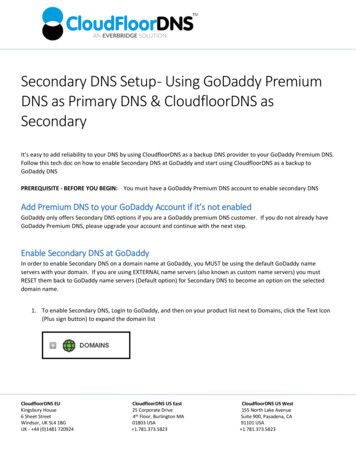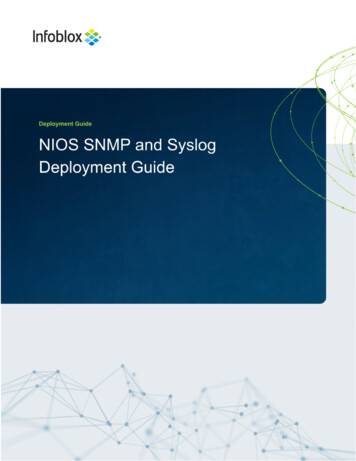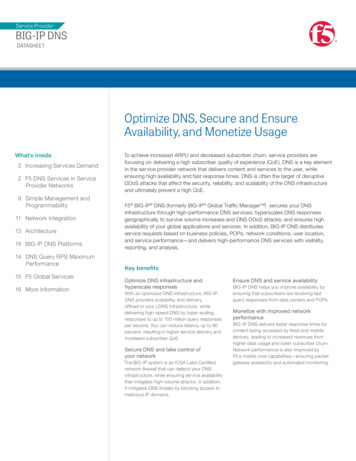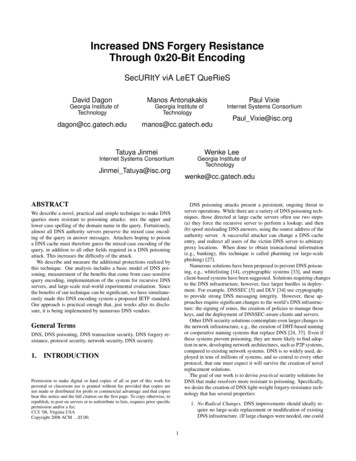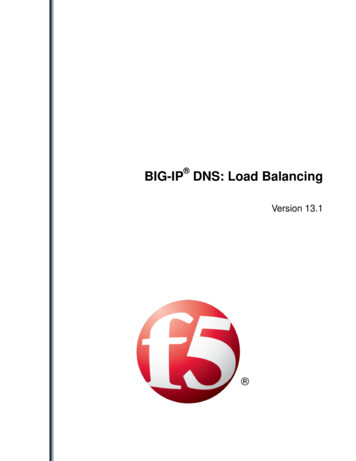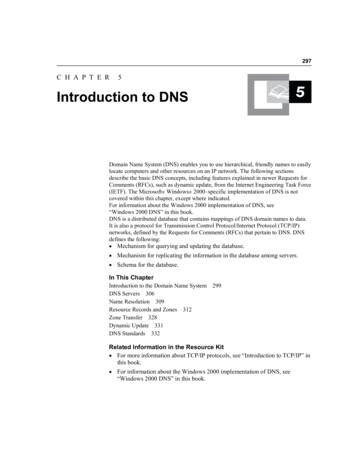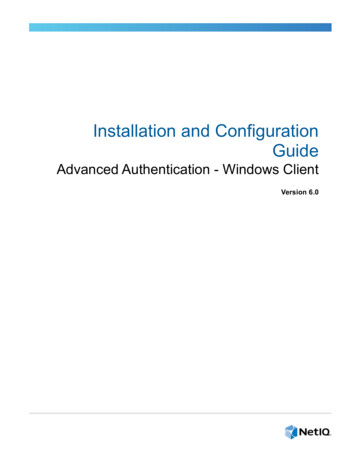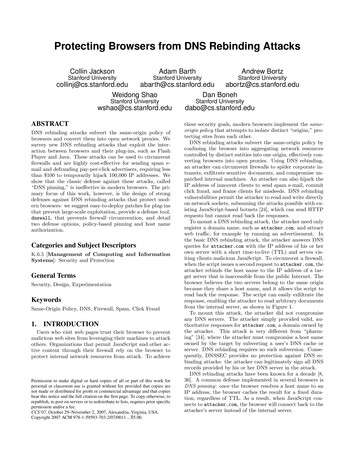
Transcription
Protecting Browsers from DNS Rebinding AttacksCollin JacksonAdam BarthAndrew BortzStanford UniversityStanford UniversityStanford d.eduabortz@cs.stanford.eduWeidong ShaoDan BonehStanford UniversityStanford uABSTRACTDNS rebinding attacks subvert the same-origin policy ofbrowsers and convert them into open network proxies. Wesurvey new DNS rebinding attacks that exploit the interaction between browsers and their plug-ins, such as FlashPlayer and Java. These attacks can be used to circumventfirewalls and are highly cost-effective for sending spam email and defrauding pay-per-click advertisers, requiring lessthan 100 to temporarily hijack 100,000 IP addresses. Weshow that the classic defense against these attacks, called“DNS pinning,” is ineffective in modern browsers. The primary focus of this work, however, is the design of strongdefenses against DNS rebinding attacks that protect modern browsers: we suggest easy-to-deploy patches for plug-insthat prevent large-scale exploitation, provide a defense tool,dnswall, that prevents firewall circumvention, and detailtwo defense options, policy-based pinning and host nameauthorization.Categories and Subject DescriptorsK.6.5 [Management of Computing and InformationSystems]: Security and ProtectionGeneral TermsSecurity, Design, ExperimentationKeywordsSame-Origin Policy, DNS, Firewall, Spam, Click Fraud1.INTRODUCTIONUsers who visit web pages trust their browser to preventmalicious web sites from leveraging their machines to attackothers. Organizations that permit JavaScript and other active content through their firewall rely on the browser toprotect internal network resources from attack. To achievePermission to make digital or hard copies of all or part of this work forpersonal or classroom use is granted without fee provided that copies arenot made or distributed for profit or commercial advantage and that copiesbear this notice and the full citation on the first page. To copy otherwise, torepublish, to post on servers or to redistribute to lists, requires prior specificpermission and/or a fee.CCS’07, October 29–November 2, 2007, Alexandria, Virginia, USA.Copyright 2007 ACM 978-1-59593-703-2/07/0011 . 5.00.these security goals, modern browsers implement the sameorigin policy that attempts to isolate distinct “origins,” protecting sites from each other.DNS rebinding attacks subvert the same-origin policy byconfusing the browser into aggregating network resourcescontrolled by distinct entities into one origin, effectively converting browsers into open proxies. Using DNS rebinding,an attacker can circumvent firewalls to spider corporate intranets, exfiltrate sensitive documents, and compromise unpatched internal machines. An attacker can also hijack theIP address of innocent clients to send spam e-mail, commitclick fraud, and frame clients for misdeeds. DNS rebindingvulnerabilities permit the attacker to read and write directlyon network sockets, subsuming the attacks possible with existing JavaScript-based botnets [24], which can send HTTPrequests but cannot read back the responses.To mount a DNS rebinding attack, the attacker need onlyregister a domain name, such as attacker.com, and attractweb traffic, for example by running an advertisement. Inthe basic DNS rebinding attack, the attacker answers DNSqueries for attacker.com with the IP address of his or herown server with a short time-to-live (TTL) and serves visiting clients malicious JavaScript. To circumvent a firewall,when the script issues a second request to attacker.com, theattacker rebinds the host name to the IP address of a target server that is inaccessible from the public Internet. Thebrowser believes the two servers belong to the same originbecause they share a host name, and it allows the script toread back the response. The script can easily exfiltrate theresponse, enabling the attacker to read arbitrary documentsfrom the internal server, as shown in Figure 1.To mount this attack, the attacker did not compromiseany DNS servers. The attacker simply provided valid, authoritative responses for attacker.com, a domain owned bythe attacker. This attack is very different from “pharming” [34], where the attacker must compromise a host nameowned by the target by subverting a user’s DNS cache orserver. DNS rebinding requires no such subversion. Consequently, DNSSEC provides no protection against DNS rebinding attacks: the attacker can legitimately sign all DNSrecords provided by his or her DNS server in the attack.DNS rebinding attacks have been known for a decade [8,36]. A common defense implemented in several browsers isDNS pinning: once the browser resolves a host name to anIP address, the browser caches the result for a fixed duration, regardless of TTL. As a result, when JavaScript connects to attacker.com, the browser will connect back to theattacker’s server instead of the internal server.
Browserclientattacker.comat time t0TechnologyLiveConnect (JVM loaded)Flash Player 9Internet Explorer 6 (no plug-ins)Internet Explorer 7 (no plug-ins)Firefox 1.5 and 2 (no plug-ins)Safari 2 (no plug-ins)LiveConnectOpera 9 (no plug-ins)Attackerwebserverattacker.comat time t1Table 1: Time Required for DNS Rebinding Attackby Technology (95% Confidence)3. We propose two options for protecting browsers fromDNS rebinding: smarter pinning that provides bettersecurity and robustness, and a backwards-compatibleuse of the DNS system that fixes rebinding vulnerabilities at their root (which we implemented as a 72-linepatch to Firefox 2).TargetserverFigure 1: Firewall Circumvention Using RebindingPinning is no longer an effective defense against DNS rebinding attacks in current browsers because of vulnerabilities introduced by plug-ins. These plug-ins provide additional functionality, including socket-level network access,to web pages. The browser and each plug-in maintain separate pin databases, creating a new class of vulnerabilitieswe call multi-pin vulnerabilities that permit an attacker tomount DNS rebinding attacks. We demonstrate, for example, how to exploit the interaction between the browser andJava LiveConnect to pin the browser to one IP address whilepinning Java to another IP address, permitting the attackerto read and write data directly on sockets to a host andport of the attacker’s choice despite strong pinning by eachcomponent.Our experiments show how an attacker can exploit multipin vulnerabilities to cheaply and efficiently assemble a temporary, large-scale bot network. Our findings suggest thatnearly 90% of web browsers are vulnerable to rebinding attacks that only require a few hundreds of milliseconds toconduct (see Table 1). These attacks do not require usersto click on any malicious links: users need only view an attacker’s web advertisement. By spending less than 100 onadvertising, an attacker can hijack 100,000 unique IP address to send spam, commit click fraud, or otherwise misuseas open network proxies.The bulk of our work focuses on designing robust defensesto DNS rebinding attacks that protect current and futurebrowsers and plug-ins:1. To combat firewall circumvention, we recommend organizations deploy DNS resolvers that prevent externalnames from resolving to internal addresses. We provide an open-source implementation of such a resolverin 300 lines of C called dnswall [15].2. For Flash Player, Java, and LiveConnect, we suggestspecific, easy-to-deploy patches to prevent multi-pinvulnerabilities, mitigating large-scale exploitation ofDNS rebinding for firewall circumvention and IP hijacking.Attack Time47.8 10.3 ms192 5.7 ms1000 ms1000 ms1000 ms1000 ms1294 37 ms4000 msThe remainder of the paper is organized as follows. Section 2 describes existing browser policy for network access.Section 3 details DNS rebinding vulnerabilities, includingstandard DNS rebinding and current multi-pin vulnerabilities. Section 4 explains two classes of attacks that use thesevulnerabilities, firewall circumvention and IP hijacking, andcontains our experimental results. Section 5 proposes defenses against both classes of attacks. Section 6 describesrelated work. Section 7 concludes.2.NETWORK ACCESS IN THE BROWSERTo display web pages, browsers are instructed to makenetwork requests by static content such as HTML and byactive content such as JavaScript, Flash Player, Java, andCSS. Browsers restrict this network access in order to to prevent web sites from making malicious network connections.The same-origin policy provides partial resource isolationby restricting access according to origin, specifying whencontent from one origin can access a resource in another origin. The policy applies to both network access and browserstate such as the Document Object Model (DOM) interface,cookies, cache, history, and the password database [20]. Theattacks described in this paper circumvent the same originpolicy for network access.Access Within Same Origin. Within the same origin,both content and browser scripts can read and write network resources using the HTTP protocol. Plug-ins, such asFlash Player and Java, can access network sockets directly,allowing them to make TCP connections and, in some cases,send and receive UDP packets as well. Java does not restrictaccess based on port number, but Flash Player permits access to port numbers less than 1024 only if the machineauthorizes the connection in an XML policy served from aport number less than 1024.Access Between Different Origins. In general, content from one origin can make HTTP requests to serversin another origin, but it cannot read responses, effectivelyrestricting access to “send-only.” Flash Player permits itsmovies to read back HTTP responses from different origins,provided the remote server responds with an XML policyauthorizing the movie’s origin. Flash Player also permits
reading and writing data on TCP connections to arbitraryport numbers, again provided the remote server respondswith a suitable XML policy on an appropriate port.By convention, certain types of web content are assumedto be public libraries, such as JavaScript, CSS, Java applets, and SWF movies. These files may be included acrossdomains. For example, one origin can include a CSS filefrom another origin and read its text. Scripts can also readcertain properties of other objects loaded across domains,such as the height and width of an image.Prohibited Access. Some types of network access are prohibited even within the same origin. Internet Explorer 7blocks port numbers 19 (chargen), 21 (FTP), 25 (SMTP),110 (POP3), 119 (NNTP), and 143 (IMAP), Firefox 2 blocksthose plus 51 additional port numbers, but Safari 2 does notblock any ports. Some of these port restrictions are designedto prevent malicious web site operators from leveraging visiting browsers to launch distributed denial of service or tosend spam e-mail, whereas others prevent universal crosssite scripting via the HTML Form Protocol Attack [41].Origin Definition. Different definitions of “origin” areused by different parts of the browser. For network access,browsers enforce the same-origin policy [38] based on threecomponents of the Uniform Resource Locator (URL) fromwhich it obtained the content. A typical URL is composedof the below components:scheme://hostname:port/pathCurrent browsers treat two objects as belonging to the sameorigin if, and only if, their URLs contain the same scheme,host name, and port number (e.g., http://amazon.com/ isa different origin than http://amazon.co.uk/, even thoughthe two domains are owned by the same company). Otherresources use fewer components of the URL. For example,cookies use only the host name.Objects on the Internet, however, are not accessed by hostname. To connect to a server, the browser must first translate a host name into an IP address and then open a socketto that IP address. If one host name resolves to multiple IPaddresses owned by multiple entities, the browser will treatthem as if they were the same origin even though they are,from an ownership point-of-view, different.3.DNS REBINDING VULNERABILITIESThe network access policy in web browsers is based onhost names, which are bound by the Domain Name System (DNS) to IP addresses. An attacker mounting a DNSrebinding attack attempts to subvert this security policy bybinding his or her host name to both the attack and targetserver’s IP addresses.3.1Standard Rebinding VulnerabilitiesA standard rebinding attack uses a single browser technology (e.g. JavaScript, Java, or Flash Player) to connectto multiple IP addresses with the same host name.Multiple A Records. When a client resolves a host nameusing DNS, the authoritative server can respond with multiple A records indicating the IP addresses of the host. Thefirst attack using DNS rebinding [8] in 1996 leveraged thisproperty to confuse the security policy of the Java VirtualMachine (JVM):1. A client visits a malicious web site, attacker.com, containing a Java applet. The attacker’s DNS server bindsattacker.com to two IP addresses: the attacker’s webserver and the target’s web server.2. The client executes the attacker’s applet, which opensa socket to the target. The JVM permits this connection, because the target’s IP address is contained inthe DNS record for attacker.com.Current versions of the JVM are not vulnerable to this attack because the Java security policy has been changed. Applets are now restricted to connecting to the IP address fromwhich they were loaded. (Current attacks on Java are described in Section 3.2.)In the JavaScript version of this attack, the attacker sendssome JavaScript to the browser that instructs the browserto connect back to attacker.com. The attacker’s serverrefuses this second TCP connection, forcing the browser toswitch over to the victim IP address [21]. By using a RSTpacket to refuse the connection, the attacker can cause somebrowsers to switch to the new IP address after one second.Subsequent XMLHttpRequests issued by the attacker’s codewill connect to the new IP address.Time-Varying DNS. In 2001, the original attack on Javawas extended [36] to use use time-varying DNS:1. A client visits a malicious web site, attacker.com,containing JavaScript. The attacker’s DNS server isconfigured to bind attacker.com to the attacker’s IPaddress with a very short TTL.2. The attacker rebinds attacker.com to the target’s IPaddress.3. The malicious script uses frames or XMLHttpRequestto connect to attacker.com, which now resolves to theIP address of the target’s server.Because the connection in Step 3 has the same host nameas the original malicious script, the browser permits the attacker to read the response from the target.Pinning in Current Browsers. Current browsers defendagainst the standard rebinding attack by “pinning” hostnames to IP address, preventing host names from referringto multiple IP addresses. Internet Explorer 7 pins DNS bindings for 30 minutes.1Unfortunately, if the attacker’s domain has multiple Arecords and the current server becomes unavailable,the browser will try a different IP address within onesecond. Internet Explorer 6 also pins DNS bindings for 30 minutes, but an attacker can cause the browser to releaseits pin after one second by forcing a connection to thecurrent IP address to fail, for example by including theelement img src "http://attacker.com:81/" .1The duration is set by the registry keys DnsCacheTimeoutand ServerInfoTimeOut inHKEY CURRENT USER\SOFTWARE\Microsoft Windows\CurrentVersion\Internet Settings
Firefox 1.5 and 2 cache DNS entries for between 60 and120 seconds. DNS entries expire when the value of thecurrent minute increments twice. 2 Using JavaScript,the attacker can read the user’s clock and computewhen the pin will expire. Using multiple A records, anattacker can further reduce this time to one second. Opera 9 behaves similarly to Internet Explorer 6. Inour experiments, we found that it pins for approximately 12 minutes but can be tricked into releasing itspin after 4 seconds by connecting to a closed port. Safari 2 pins DNS bindings for one second. Becausethe pinning time is so low, the attacker may need tosend a “Connection: close” HTTP header to ensurethat the browser does not re-use the existing TCP connection to the attacker.Flash Player 9. Flash Player 9 permits SWF movies toopen TCP sockets to arbitrary hosts, provided the destination serves an XML policy authorizing the movie’s origin [2].According to Adobe, Flash Player 9 is installed on 55.8% ofweb browsers (as of December 2006) [1]; according to ourown experiments, Flash Player 9 was present in 86.9% ofbrowsers. Flash Player is vulnerable to the following rebinding attack:1. The client’s web browser visits a malicious web sitethat embeds a SWF movie.2. The SWF movie opens a socket on a port less than1024 to attacker.com, bound to the attacker’s IP address. Flash Player sends policy-file-request / .3. The attacker responds with the following XML: ?xml version "1.0"? cross-domain-policy allow-access-from domain "*" to-ports "*" / /cross-domain-policy 4. The SWF movie opens a socket to an arbitrary portnumber on attacker.com, which the attacker has rebound to the target’s IP address.The policy XML provided by the attacker in step 3 instructs Flash Player to permit arbitrary socket access toattacker.com. Flash Player permits the socket connectionsto the target because it does not pin host names to a singleIP address. If the attacker were to serve the policy file froma port number 1024, Flash Player would authorize onlyports 1024.3.2Multi-Pin VulnerabilitiesCurrent browsers use several plug-ins to render web pages,many of which permit direct socket access back to their origins. Another class of rebinding attacks exploit the factthat these multiple technologies maintain separate DNS pindatabases. If one technology pins to the attacker’s IP address and another pins to the target’s IP address, the attacker can make use of inter-technology communication tocircumvent the same-origin restrictions on network access.Some of these attacks have been discussed previously in thefull-disclosure community [4].Java. Java, installed on 87.6%3 of web browsers [1], can also23The duration is set by network.dnsCacheExpiration.We observed 98.1% penetration in our experiment.open TCP connections back to their origins. The Java Virtual Machine (JVM) maintains DNS pins separately fromthe browser, opening up the possibility of DNS rebindingvulnerabilities. Java applets themselves are not vulnerablebecause the JVM retrieves applets directly from the network, permitting the JVM to pin the origin of the applet tothe correct IP address. Java is vulnerable, however, to thefollowing attacks. LiveConnect bridges JavaScript and the JVM in Firefox and Opera, permitting script access to the Javastandard library, including the Socket class, withoutloading an applet. The browser pins to the attacker’sIP address, but the JVM spawned by LiveConnectdoes a second DNS resolve and pins to the target’sIP address. The attacker’s JavaScript can exploit thispin mismatch to open and communicate on a socketfrom the client machine to an arbitrary IP address onan arbitrary destination port, including UDP socketswith a source port number 1024. Applets with Proxies are also vulnerable to a multipin attack, regardless of which browser the client uses.If the client uses an HTTP proxy to access the web,there is yet another DNS resolver involved—the proxy.When the JVM retrieves an applet via a proxy, it requests the applet by host name, not by IP address.If the applet opens a socket, the JVM does a secondDNS resolve and pins to the target’s IP address. Relative Paths can cause multi-pin vulnerabilities. Ifa server hosts an HTML page that embeds an appletusing a relative path with the parameter mayscriptset to true, that machine can be the target of a multipin attack. The browser pins to the target, retrievesthe HTML page, and instructs the JVM to load theapplet. The JVM does a second DNS resolve, pinsto the attacker, and retrieves a malicious applet. Theapplet instructs the browser, via JavaScript, to issueXMLHttpRequests to the target’s IP address.Flash Player. Flash Player would still be vulnerable tomulti-pin attacks even if it pinned DNS bindings. FlashPlayer does not retrieve its movies directly from the network. Instead, the browser downloads the movie and spawnsFlash Player, transferring the movie’s origin by host name.When the attacker’s movie attempts to open a socket, FlashPlayer does a second DNS resolution and would pin to thetarget’s IP address. The URLLoader class is not vulnerable tomulti-pin attacks because it uses the browser to request theURL and thus uses the browser’s DNS pins, but the Socketclass could still be used to read and write on arbitrary TCPsockets.Other Plug-ins. Other browser plug-ins permit networkaccess, including Adobe Acrobat and Microsoft Silverlight.Acrobat restricts network communication to the SOAP protocol but does not restrict access by document origin. Often, the Acrobat plug-in will prompt the user before accessing the network. Silverlight permits network access throughBrowserHttpWebRequest, which uses the browser to makethe request (like URLLoader in Flash Player) and thus usesthe browser’s DNS pins.
4.ATTACKS USING DNS REBINDINGAn attacker can exploit the DNS rebinding vulnerabilitiesdescribed in Section 3 to mount a number of attacks. Forsome of these attacks, the attacker requires the direct socketaccess afforded by DNS rebinding with Flash Player andJava, whereas others require only the ability to read HTTPresponses from the target. The attacks fall into two broadcategories, according to the attacker’s goal: Firewall Circumvention. The attacker can use DNS rebinding to access machines behind firewalls that he orshe cannot access directly. With direct socket access,the attacker can interact with a number of internalservices besides HTTP. IP Hijacking. The attacker can also use DNS rebindingto access publicly available servers from the client’s IPaddress. This allows the attacker to take advantage ofthe target’s implicit or explicit trust in the client’s IPaddress.To mount these attacks, the attacker must first induce theclient to load some active content. This can be done by avariety of techniques discussed in Section 4.4. Once loadedonto the client’s machine, the attacker’s code can communicate with any machine reachable by the client.4.1Firewall CircumventionA firewall restricts traffic between computer networks indifferent zones of trust. Some examples include blockingconnections from the public Internet to internal machinesand mediating connections from internal machines to Internet servers with application-level proxies. Firewall circumvention attacks bypass the prohibition on inbound connections, allowing the attacker to connect to internal serverswhile the user is visiting the attacker’s Internet web page(see Figure 1).Spidering the Intranet. The attacker need not specifythe target machine by IP address. Instead, the attackercan guess the internal host name of the target, for examplehr.corp.company.com, and rebind attacker.com to a CNAMErecord pointing to that host name. The client’s own recursive DNS resolver will complete the resolution and returnthe IP address of the target. Intranet host names are oftenguessable and occasionally disclosed publicly [30, 9]. Thistechnique obviates the need for the attacker to scan IP addresses to find an interesting target but does not work withthe multiple A record technique described in Section 3.1.Having found a machine on the intranet, the attacker canconnect to the machine over HTTP and request the rootdocument. If the server responds with an HTML page, theattacker can follow links and search forms on that page,eventually spidering the entire intranet. Web servers insidecorporate firewalls often host confidential documents, relying on the firewall to prevent untrusted users from accessingthe documents. Using a DNS rebinding attack, the attackercan leverage the client’s browser to read these documentsand exfiltrate them to the attacker, for example by submitting an HTML form to the attacker’s web server.Compromising Unpatched Machines. Network administrators often do not patch internal machines as quicklyas Internet-facing machines because the patching process istime-consuming and expensive. The attacker can attemptto exploit known vulnerabilities in machines on the internalnetwork. In particular, the attacker can attempt to exploitthe client machine itself. The attacks against the client itself originate from localhost and so bypass software firewalls and other security checks, including many designed toprotect serious vulnerabilities. If an exploit succeeds, theattacker can establish a presence within the firewall thatpersists even after clients close their browsers.Abusing Internal Open Services. Internal networkscontain many open services intended for internal use only.For example, network printers often accept print jobs frominternal machines without additional authentication. Theattacker can use direct socket access to command networkprinters to exhaust their toner and paper supplies.Similarly, users inside firewalls often feel comfortable creating file shares or FTP servers accessible to anonymoususers under the assumption that the servers will be available only to clients within the network. With the ability toread and write arbitrary sockets, the attacker can exfiltratethe shared documents and use these servers to store illicitinformation for later retrieval.Consumer routers are often installed without changing thedefault password, making them an attractive target for reconfiguration attacks by web pages [40]. Firmware patcheshave attempted to secure routers against cross-site scriptingand cross-site request forgery, in an effort to prevent reconfiguration attacks. DNS rebinding attacks allow the attackerdirect socket access to the router, bypassing these defenses.4.2IP HijackingAttackers can also use DNS rebinding attacks to targetmachines on the public Internet. For these attacks, the attacker is not leveraging the client’s machine to connect tootherwise inaccessible services but instead abusing the implicit or explicit trust public services have in the client’s IPaddress. Once the attacker has hijacked a client’s IP address, there are several attacks he or she can perpetrate.Committing Click Fraud. Web publishers are often paidby web advertisers on a per-click basis. Fraudulent publishers can increase their advertising revenue by generating fakeclicks, and advertisers can drain competitors’ budgets byclicking on their advertisements. The exact algorithms usedby advertising networks to detect these “invalid” clicks areproprietary, but the IP address initiating the click is widelybelieved to be an essential input. In fact, one common useof bot networks is to generate clicks [7].Click fraud would appear to require only the ability tosend HTTP requests to the advertising network, but advertisers defend against the send-only attacks, permitted by thesame-origin policy, by including a unique nonce with everyadvertising impression. Clicks lacking the correct nonce arerejected as invalid, requiring the attacker to read the noncefrom an HTTP response in order to generate a click.This attack is highly cost-effective, as the attacker canbuy advertising impressions, which cost tens of cents perthousand, and convert them into clicks, worth tens of centseach. The attack is sufficiently cost-effective that the attacker need not convert every purchased impression into aclick. Instead, the fraudster can use most of the purchasedimpressions to generate fake impressions on the site, maintaining a believable click-through rate.
Framing Clients. An attacker who hijacks an IP addresscan perform misdeeds and frame the client. For example,an attacker can attempt to gain unauthorized access to acomputer system using a hijacked IP address as a proxy.As the attack originates from the hijacked IP address, thelogs will implicate the client, not the attacker, in the crime.Moreover, if the attacker hosts the malicious web site overHTTPS, the browser will not cache the page and no traceswill be left on the client’s machine.4.3Proof-of-Concept DemonstrationWe developed proof-of-concept exploits for DNS rebindingvulnerabilities in Flash Player 9, LiveConnect, Java appletswith proxy servers, and the browser itself. Our system consists of a custom DNS server authoritative for dnsrebinding.net,a custom Flash Player policy server, and a standard Apacheweb server. The various technologies issue DNS queriesthat encode the attacker and target host names, togetherwith a nonce, in the subdomain. For each nonce, the DNSserver first responds with the attacker’s IP address (with azero TTL) and thereafter with the target’s IP address. Ourproof-of-concept demo, http://crypto.stanford.edu/dns,implements wget and telnet by mounting a rebinding attack against the browser.4.4Experiment: Recruiting BrowsersMethodology. We tested DNS rebinding experimentallyby running a Flash Player 9 advertisement on a minor advertising network targeting the keywords “Firefox,” “game,”“Internet Explorer,” “video,” and “YouTube.” The experiment used two machines in our laboratory, an attacker and atarget. The attacker ran a custom authoritative DNS serverfor dnsrebinding.net, a custom Flash Player policy server,and an Apache web server hosting the advertisement. Thetarget ran an Apache web server to log successful attacks.The Flash Player advertisement exploited the vulnerabilitydescribed in Section 3.1 to load an XML document from thetarget server in our lab. The attack required only that theclient view the ad, not that the user click on the ad.Impressions86.9%24.4%2.2%90.6%Table 2: Percentage of Impressions by VulnerabilityCumulative Duration of Successful Attacksfor 7
vide an open-source implementation of such a resolver in 300 lines of C called dnswall [15]. 2. For Flash Player, Java, and LiveConnect, we suggest specific, easy-to-deploy patches to prevent multi-pin vulnerabilities, mitigating large-scale exploitation of DNS rebinding for firewall circumvention and IP hi-jacking. Technology Attack Time
